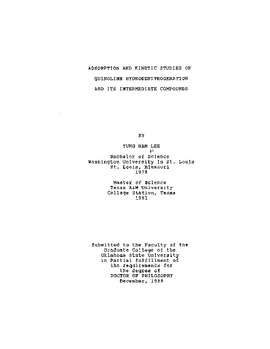| dc.contributor.advisor | Seapan, Mayis | |
| dc.contributor.author | Lee, Yung Nam | |
| dc.date.accessioned | 2015-11-09T22:23:16Z | |
| dc.date.available | 2015-11-09T22:23:16Z | |
| dc.date.issued | 1988-12 | |
| dc.identifier.uri | https://hdl.handle.net/11244/21249 | |
| dc.description.abstract | Removal of nitrogen containing aromatic compounds from hydrocarbon feedstocks in refinery operations is critical because of the poisonous nature of these compounds to the catalytic processes. Quinoline is frequently used as a model compound to study catalytic hydrodenitrogenation (HDN) of the nitrogen compounds. | |
| dc.description.abstract | Previous studies on this compound reported on the reaction network of quinoline and the modeling based solely on the kinetic data. Separate studies on the adsorption of quinoline or its intermediates on the HDN catalysts have not been done previously. In this work, separate studies of adsorption and kinetics of quinoline and its intermediates were performed. The experiments were conducted at the typical reaction conditions of 350 C and 10.34 MPa (1500 psig). Each individual intermediate compound in the reaction network was studied separately. The experiments were performed in a gradientless reactor with Berty internals. The reactor was operated in a closed system for the adsorption studies and in a continuous flow system for the kinetic studies. | |
| dc.description.abstract | The adsorption constants thus obtained indicated that different intermediate compounds have different adsorption characteristics which is contrary to previous thinking in the literature that most of the nitrogen compounds have similar adsorption strengths. The compound 1,2,3,4-tetrahydroquinoline (1-THQ) was found to have the highest adsorption strength. The individual rate parameter for each step in the reaction network was obtained from the kinetic data of each intermediate compound. The formation of decahydroquinoline was found to be favored over the formation of OPA from 1-THQ. The limiting step in overall HDN rate was the conversion of 1-THQ. This was assumed to be related to the strong adsorption of 1-THQ on the catalyst. Propylbenzene was found to convert readily to propylcyclohexane under reaction conditions. A new reaction network for quinoline HDN was obtained from combining all of this information which is slightly different from the existing network for quinoline HDN. | |
| dc.format | application/pdf | |
| dc.language | en_US | |
| dc.rights | Copyright is held by the author who has granted the Oklahoma State University Library the non-exclusive right to share this material in its institutional repository. Contact Digital Library Services at lib-dls@okstate.edu or 405-744-9161 for the permission policy on the use, reproduction or distribution of this material. | |
| dc.title | Adsorption and kinetic studies of quinoline hydrodenitrogenation and its intermediate compounds | |
| dc.contributor.committeeMember | Eisenbraun, E. J. | |
| dc.contributor.committeeMember | Johnson, M. M. | |
| dc.contributor.committeeMember | Robinson, Robert L., Jr. | |
| osu.filename | Thesis-1988D-L482a.pdf | |
| osu.accesstype | Open Access | |
| dc.type.genre | Dissertation | |
| dc.type.material | Text | |
| thesis.degree.discipline | Chemical Engineering | |
| thesis.degree.grantor | Oklahoma State University | |
